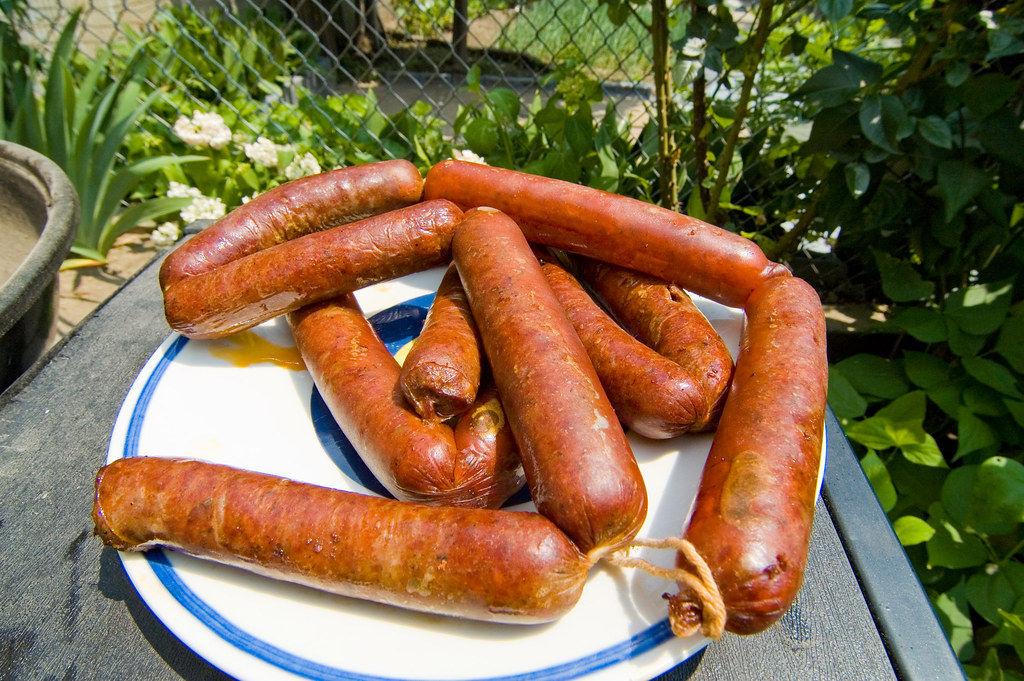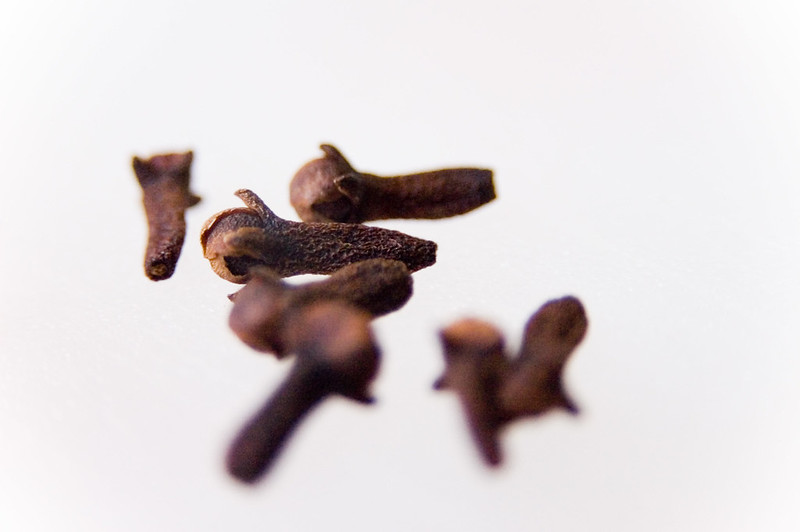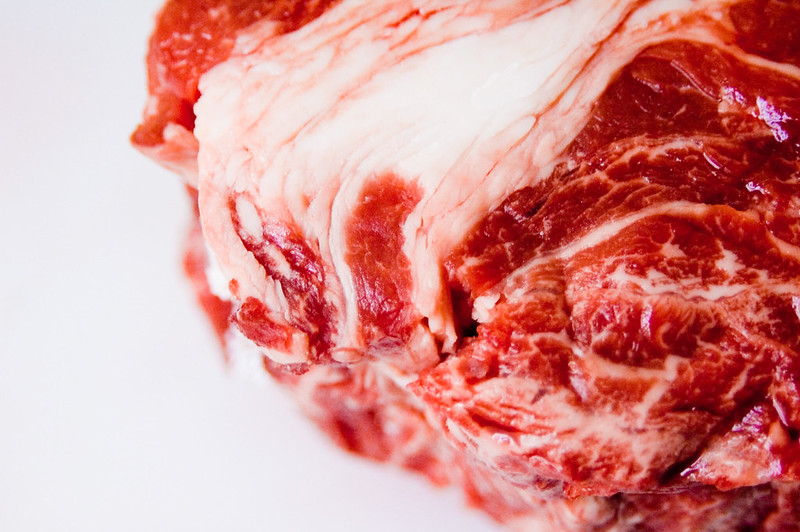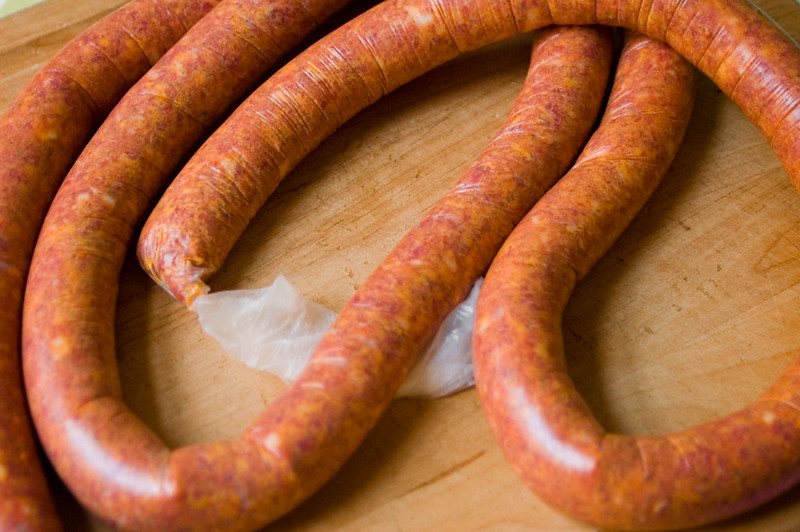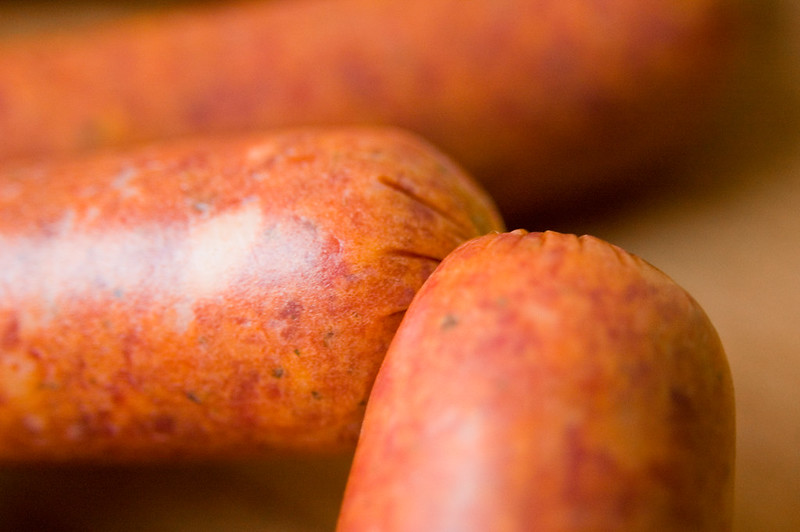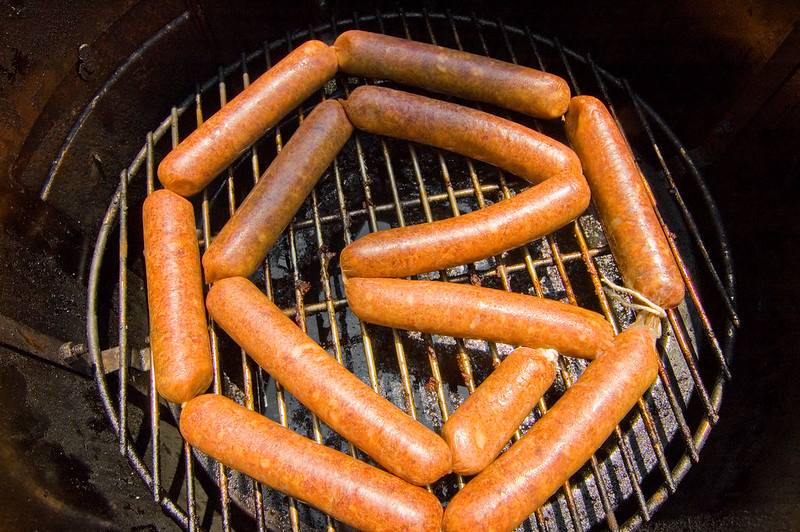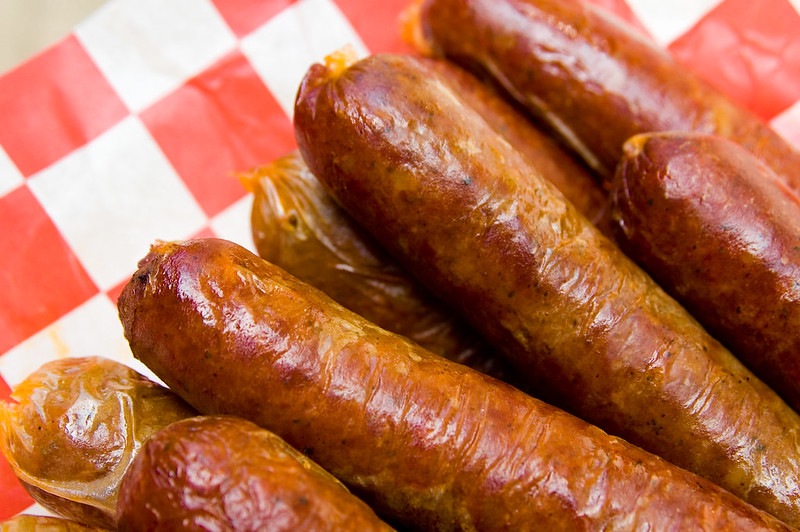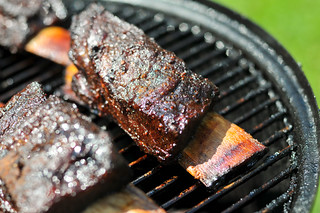Hot Links
Is there something wrong with you when almost every moment of your day, waking and sleeping, is filled with thoughts of juicy, spicy hot sausages? This is what life has been for me ever since the Big Apple Barbecue Block Party three weeks ago. After consuming a hot link made by Southside Market, it's seemed as if my whole goal in life is to eat more of these overly delicious tubes of spiced beef. I'm even considering taking 1/2 a day of an upcoming 2 day trip to Houston to drive to Elgin to feed my addiction, but even that seems too far away and has not released my brain for alternative thoughts (it's amazing how my designs at work have become very sausage centric). I had to have more, and I had to have it now, so I did the best thing I could think of, and made some of my own.
From the start I was wary of my ability to replicate the taste of perfection that Southside's sausage has, and was a little put off by the recipe in my only sausage book (Bruce Aidell's Complete Sausage Book) that uses a huge array of spices, something I'm sure Southside does not use. My desire was too strong though, and I forged ahead with the recipe, determined to bring a little taste of Texas to Astoria.
I did search around on the internet first for an alternative recipe before settling on the one I had on hand. My biggest problem was that all recipes I found either used 100% pork or a mixture of pork and beef, and I'm pretty sure the Elgin Hot Sausages are 100% beef. Bruce Aidell's recipe had a 3:1 beef to pork ratio and I figured if I altered that to 100% beef, I wasn't going to do much harm. So I went to the butcher and picked out the fattest chuck roast they had (2lbs), and added pork fat back (1lb) for a good meat to fat ratio that would hopefully produce a succulent final product.
I must say that the sausage stuffing process went so much smoother than my previous attempt, which was riddled with so many mishaps that one would think that making sausages at home was well beyond my reach. I did, however, cut my finger pretty badly, which happened when trying to cut the pork fat from the skin. This new scar has led me to offer the following pieces of advice: keep the fatback well refrigerated while working with it, use a paper towel to grip the knife, and buy a piece of thick fatback. The first problem was that fat started melting quickly at room temperature, causing everything I touched in my kitchen to become slippery and greasy, hence the knife slipping. I could have avoided the knife slipping at all if I had used a paper towel to get a better grip on it, which I did only after the slashing occurred. It would have also helped to have fatback with a thicker layer of fat. I asked three butchers for fatback, all were without it, but one pointed me to the grocery store, which had a whole stockpile of the stuff. The problem was that there was only about 1/4 inch of fat, which was terribly difficult to separate from the skin. I've since bought a bunch of fatback from my local CSA farmer that has at least an inch of fat, so it should be much easier to cut off.
When stuffing the sausages this time, I was able to stuff the entire casing without and breaks. This was partly due to experience, along with making sure the casing was not being overstuffed. Keeping the stuffing a little looser also helped with linking, which also went off without a hitch. The entire process that took me nearly 3 hours just a month ago, I completed in under an hour, and I was able to stand back and give myself a small pat on the back, feeling very accomplished in the field of sausage production.
After an an overnight stint in the fridge to air dry, it was time to smoke these babies. I cooked these at the same time as my ribs were finishing their last couple hours in the 225 degree smoker with oak and apple wood chunks. The recipe called for smoking for 1 1/2 to 4 hours, until an internal temperature between 155 - 160 degrees. When I went to take their temp after one hour of cooking, I was pretty shocked to see my thermometer tell me they were already at 170 degrees. I frantically tested almost every link, praying I didn't over cook them all, but alas, they were all between 165 - 170 degrees, so I pulled them off to rest, hoping a 5-10 degree overcook wouldn't kill my reward for the hard work I put into these.
I was so eager to try one that I couldn't wait for them to cool. Cutting into the first link, a spray of hot, spicy fat came squirting up into my face and all over the kitchen, but there was no time to clean it up, I had to have my sausage. First bite; these were a let down, they were not the Elgin Hot Sausages that I had be craving. Second bite so they're not Elgin Hot Suasages, so what, they're still tasty, if not a bit on the dry side. Third bite: OMG, all my sausages have gone from plump to wrinkled . It seems leaving the casings a little under stuffed allowed them to expand with fat juice while cooking, but then shrivel down when cooled. So my sausages weren't Southsides, so they looked a little withered, who cares? Throw one of these on the grill to heat up and I still had a sausage that was better then what you buy in the store, and that all of my friends seemed to enjoy. It's still hard to get those Elgin Hot Sausages off my mind, but at least these helped alleviate some of my obsession, anyway, do I really want get sausage out of my head?
You Might Also Like
Comments
-
Ronald Gast No cure listed for the hot link recipe?
Rather risky -
DH from Texas That recipe looks a lot more like a Hungarian/Southern Austrian sausage (the combination of Hungarian paprika, cardamom, marjoram, *and* allspice looks very Continental), and not so much like a hot-gut/hot-links.
The links Southside sells prepackaged at the grocery store (H-E-B for most of us in Texas) is 100% beef, but it's made differently than what you'll get at the barbecue counter.
At the counter, you're most-likely getting Southside's version of Smitty's (aka 'Hill Country') sausage, or you might have ordered their Jalapeno sausage. True at Elgin, Bastrop, or even Austin/The Domain.
This sausage is about 85% beef, and it's what a barbecue restaurant does with their beef trimmings to help out the bottom line. It'll have about 15% pork, and the seasonings are mostly black pepper, salt, with a little bit of mustard and maybe cayenne. It'll have a bit of a soy binder because ground beef that isn't pureed can be hard to get a good emulsion that won't break in the Texas heat. And pureeing takes too many steps for a production barbecue joint.
Your beef - chuck is about 70-30 lean-fat, and this sausage should be a little fatter. Try using the fatty-end of a brisket flat (you can use the lean end for something else, like hot dogs or hot guts/actual hot-links). Leave the fat cap on - you're shooting for 60-40 in the final sausage.
You added pork fat to a sausage you wanted to be all-beef - I'd have added shoulder or picnic or jowl meat, at 70-30 naturally.
Lastly, to get that authentic flavor, barbecue (smoke) it over pecan smoke, start at 200'F then raise to 260'F after flipping the links.
I can imagine having a really good offset smoker in Astoria, Queens is probably not a good idea. You may want to use something like a Camp Chef Smoke Vault and get a bag of Pecan pellets from Amazon if your local Wally-World (or grocery/hardware store) doesn't have them. I recommend B&B brand, and I also recommend their Post Oak pellets if you're going to make ribs (start with Post Oak and finish with pecan) or brisket (Post Oak all the way).
Couple of other pointers - larger batches probably should be mixed by hand (wear black nitrile 4mil gloves, just be prepared for the cold). Grind your spices in a burr grinder meant for coffee, but remove the manual arm and run it with a cordless drill - this way you can get coarse-ground pepper (most barbecue places in Central Texas will use Fiesta #32 grind Malabar black pepper) and reset it to make fine flour of the mustard seed/cayenne. Third, strongly recommend using pre-tubed 32mm hog casings (cut 'em in half for a 10lb batch), those collagen casings in your photo are plain weird to chew on in barbecue. The collagen were actually developed to make caseless sausage (like Hebrew National hotdogs) cooked sous-vide with liquid smoke and then the collagen peeled off. Next, please do use cure in a sausage you're going to smoke (not grill, but smoke). Lastly, build a spreadsheet to add spices at precise percentages, and use a scale that measures to the 0.1g if you make sub-20lb batches (thank me later).
Hill Country Sausage (DH). Use the part under the line that says 20lb, and scale it to your batch.
Ingredient Qty Unit Equiv Gram %-age
Beef 8.5 lbm 3855.53 g 76.27%
pork 1.5 lbm 680.39 g 13.46%
kosher s 2.3 ozm 65.2 g 1.29%
cayenne 1 tsp 1.8 g 0.04%
b pepper 6 tbs 41.4 g 0.82%
Chipotle 1 tsp 6.9 g 0.14%
Mustard 1 tsp 6.9 g 0.14%
Cure #1 14 g 14 g 0.28%
water 1.5 cup 354.88 g 7.02%
dry milk powder 1 ozm 28.35 g 0.56%
5055.35 100.00%
20 lbm 9071.85 g
Beef 6918.77 g
pork 1220.96 g
kosher salt 117 g
cayenne 3.23 g
b pepper 74.29 g
Chipotle 12.38 g
Mustard 12.38 g
Cure #1 25.12 g
water 636.83 g
dry milk 50.87 g
